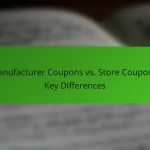Coupons are a powerful tool for shoppers looking to save money at retail chains, but understanding how to effectively use them is key. Retailers often implement targeted promotions and digital platforms to enhance customer engagement, while stacking limits dictate how many coupons can be combined for maximum savings. By mastering coupon stacking strategies, consumers can significantly reduce their expenses and make the most of their shopping experience.

How can retail chains maximize coupon usage?
Retail chains can maximize coupon usage by implementing targeted promotions, utilizing digital coupon platforms, and developing effective in-store coupon strategies. These methods not only enhance customer engagement but also drive sales and improve inventory turnover.
Targeted promotions
Targeted promotions involve customizing coupon offers based on customer data and purchasing behavior. By analyzing past purchases, retail chains can create personalized discounts that appeal to specific customer segments, increasing the likelihood of redemption.
For example, a grocery store might offer a coupon for organic products to customers who frequently purchase health-related items. This strategy can lead to higher conversion rates and customer loyalty.
Digital coupon platforms
Digital coupon platforms allow retailers to distribute coupons through mobile apps, websites, and email campaigns. These platforms often provide real-time analytics, enabling retailers to track coupon performance and adjust strategies accordingly.
Retailers should consider integrating their digital coupons with loyalty programs to further incentivize customers. For instance, offering exclusive digital coupons to loyalty members can enhance engagement and retention.
In-store coupon strategies
In-store coupon strategies include placing physical coupons near relevant products or using signage to promote available discounts. This approach captures the attention of shoppers at the point of sale, increasing the chances of coupon usage.
Retail chains can also train staff to inform customers about current coupon offers, ensuring that shoppers are aware of potential savings. However, it is crucial to avoid overwhelming customers with too many promotions, which can lead to confusion and reduced effectiveness.

What are the stacking limits for major retailers?
Stacking limits refer to the restrictions on combining multiple coupons or discounts at major retailers. Each retailer has its own policies, which can affect how much you save during a purchase.
Walmart stacking policies
Walmart generally allows customers to use one manufacturer coupon and one store coupon per item. However, they do not permit stacking multiple manufacturer coupons on the same product. It’s essential to check the specific coupon terms, as some may have additional restrictions.
For example, if you have a manufacturer coupon for $1 off a product and a Walmart store coupon for $0.50 off the same product, you can use both, bringing your total discount to $1.50. Always ensure that the coupons are valid and not expired.
Target coupon stacking rules
At Target, you can stack one manufacturer coupon with one Target coupon on a single item. Additionally, Target allows the use of Cartwheel offers alongside these coupons, increasing potential savings. However, be mindful of the total discount not exceeding the item’s price.
For instance, if you have a $2 manufacturer coupon and a $1 Target coupon for a $3 item, you can use both. If you also have a Cartwheel offer for 20% off, you can apply that as well, maximizing your savings.
CVS stacking limits
CVS allows customers to stack coupons, including manufacturer coupons, CVS coupons, and ExtraBucks rewards. However, CVS has specific policies that limit the number of coupons that can be used per item, typically one of each type.
For example, if you have a $3 manufacturer coupon and a $2 CVS coupon for the same product, you can use both. Additionally, if you have ExtraBucks rewards, you can apply those to your total purchase, enhancing your overall savings during checkout.

What strategies enhance coupon stacking?
Effective coupon stacking strategies can significantly increase savings at retail chains. By combining different types of coupons and timing purchases wisely, shoppers can maximize their discounts and minimize costs.
Combining manufacturer and store coupons
Combining manufacturer and store coupons is a powerful strategy for maximizing savings. Retailers often allow customers to use both types of coupons on a single item, which can lead to substantial discounts. For example, if a store offers a $1 off coupon and the manufacturer provides an additional $2 off, you can save $3 on that product.
However, it’s essential to check the store’s coupon policy, as some may have restrictions on stacking. Always read the fine print to ensure compliance and avoid any surprises at checkout.
Timing purchases with sales events
Timing your purchases during sales events can enhance the benefits of coupon stacking. Retailers frequently have sales on specific items, and combining these discounts with coupons can lead to significant savings. For instance, if a store has a 20% off sale on a product and you have a coupon for an additional $5 off, you can maximize your savings.
Be aware of seasonal sales, clearance events, and holiday promotions, as these are prime opportunities to stack coupons effectively. Planning your shopping around these events can yield better deals.
Using loyalty programs
Loyalty programs can complement coupon stacking by providing additional savings and exclusive offers. Many retailers reward members with points for purchases, which can be redeemed for discounts or future purchases. By stacking these rewards with coupons, you can enhance your overall savings.
Sign up for loyalty programs at your favorite stores and keep an eye out for special promotions that allow you to earn extra points or receive exclusive coupons. This strategy can lead to significant savings over time, especially if you frequently shop at those retailers.

What are the best coupon apps for savings?
The best coupon apps for savings include Rakuten, Ibotta, and Honey, each offering unique features to maximize discounts. These apps help users find and apply coupons, earn cashback, and track savings efficiently.
Rakuten cashback app
Rakuten allows users to earn cashback on purchases made through its platform at various retailers. When shopping online, users can activate cashback offers and receive a percentage back on their total spend, typically ranging from 1% to 10% or more, depending on the retailer.
To use Rakuten effectively, create an account, browse available offers, and click through to the retailer’s site. Be mindful of the payout threshold, as cashback is usually paid out quarterly via check or PayPal once you reach a certain amount, often around $5.
Ibotta savings platform
Ibotta offers users the chance to earn cash back on grocery purchases by submitting receipts or linking loyalty accounts. Users can unlock specific offers before shopping, which can provide savings on a wide range of products, often yielding savings of a few cents to several dollars per item.
To maximize Ibotta, check the app regularly for new offers and consider combining them with in-store sales or manufacturer coupons. Keep an eye on the expiration dates for offers, as they can vary significantly.
Honey coupon finder
Honey is a browser extension that automatically finds and applies coupon codes at checkout for online purchases. It works by scanning the internet for available discounts, saving users time and effort while shopping.
To use Honey, simply install the extension, shop as usual, and let Honey apply the best available coupons at checkout. It’s a straightforward way to save, but be aware that not all retailers may accept Honey’s codes, so it’s good to double-check if you’re not seeing expected savings.

How do coupon policies differ across regions?
Coupon policies vary significantly across regions, influenced by local laws, retailer practices, and consumer behavior. Understanding these differences is crucial for maximizing savings and ensuring compliance with specific regulations.
Regional retailer variations
Retailers often have distinct coupon policies depending on their location. For example, a grocery chain in the Midwest may allow double coupon stacking, while a similar store in the Southeast might not permit any stacking at all. This can affect how much you save when shopping, so it’s essential to check the specific policies of each retailer in your area.
Additionally, some retailers may offer exclusive regional promotions or loyalty programs that can enhance savings. Always stay informed about local deals and special offers to take full advantage of what’s available.
State-specific coupon regulations
In the United States, state laws can impact how coupons are issued and redeemed. Certain states may have regulations that limit the types of coupons that can be used or require specific disclosures from retailers. For instance, some states might enforce rules on expiration dates or the use of digital coupons.
It’s advisable to familiarize yourself with your state’s specific coupon regulations to avoid any issues at checkout. Checking with local consumer protection agencies or retailer websites can provide clarity on what is permissible in your region.

What are the emerging trends in couponing?
Emerging trends in couponing focus on personalization and technological integration, enhancing the shopping experience for consumers. Retailers are increasingly adopting strategies that leverage data analytics and mobile technology to deliver targeted offers and streamline redemption processes.
Personalized coupon offers
Personalized coupon offers are tailored to individual shopping habits and preferences, making them more relevant and appealing. Retailers analyze customer data to create customized discounts, which can significantly increase redemption rates compared to generic coupons.
For example, a grocery store might send a coupon for a customer’s favorite brand of cereal based on their previous purchases. This targeted approach not only improves customer satisfaction but also encourages repeat business.
Integration with mobile wallets
Integration with mobile wallets allows consumers to store and redeem coupons directly from their smartphones, simplifying the shopping process. Retailers are increasingly partnering with mobile wallet providers to facilitate easy access to discounts at checkout.
Using mobile wallets, shoppers can receive real-time notifications about available coupons and promotions, ensuring they never miss out on savings. This trend is particularly popular among younger consumers who prefer digital solutions over traditional paper coupons.










